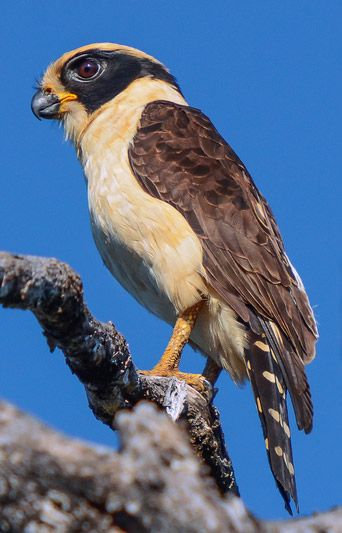Herpetotheres cachinnans: The Enigmatic Laughing Falcon

In the vast and diverse rainforests of Central and South America, a bird with a unique and enigmatic personality captures the attention of birdwatchers and researchers alike—the Laughing Falcon, scientifically known as Herpetotheres cachinnans. This fascinating species has earned its name due to its peculiar call, resembling a hearty laugh that echoes through the forest canopy. Join us as we delve into the world of this remarkable raptor and uncover the secrets behind its distinctive behaviors and characteristics.

The Laughing Falcon boasts a stunning plumage that perfectly complements its rainforest habitat. Its upperparts display shades of rich brown and rufous, providing excellent camouflage among the tree branches and foliage. The underparts are adorned with delicate white bars, which further aid in concealing its presence from unsuspecting prey and potential predators. This exceptional camouflage allows the Laughing Falcon to blend seamlessly into the dense vegetation, making it a challenging bird to spot amidst the lush greenery.

As dawn breaks and the forest awakens, the Laughing Falcon begins its morning serenade with its distinctive call, which resembles a series of loud, haunting laughter-like sounds. The resonant “ha-ha-ha-ha-ha” echoes through the treetops, giving the bird its common name. This vocal display is not only used for communication but also serves as a territorial declaration to other individuals in the vicinity. This unique and iconic call is a delight to ornithologists and nature enthusiasts who venture into the Laughing Falcon’s territory.

A formidable predator, the Laughing Falcon is primarily an avian carnivore. Its diet mainly consists of reptiles and small mammals, with a particular fondness for snakes. The bird employs a hunting strategy known as “perch and pounce,” where it patiently waits atop a tree branch, surveying the forest floor for potential prey. Once spotted, it dives down with incredible speed and accuracy to capture its target. Its powerful talons and beak allow it to subdue and consume snakes, lizards, and rodents with ease, making it an essential player in maintaining ecological balance in its habitat.
The Laughing Falcon is a solitary bird by nature and typically found alone or in pairs. During the breeding season, it constructs a simple nest made of sticks in the canopy of tall trees. Female and male partners work together to raise their offspring. After the female lays her eggs, both parents take turns incubating them and providing food for the chicks once they hatch. Despite its solitary habits, the bird exhibits exceptional parental care, ensuring the survival and growth of its young.

While the Laughing Falcon is not currently classified as a globally threatened species, its habitat and population face potential risks due to deforestation and human activities in its range. As pristine rainforests continue to dwindle, these fascinating birds may face habitat loss and fragmentation, affecting their ability to find suitable nesting sites and prey. Conservation efforts focused on preserving the bird’s habitat and raising awareness about its ecological importance are essential to ensure its continued existence in the wild.
The Laughing Falcon, Herpetotheres cachinnans, stands as a symbol of the wonders found in the world’s rainforests. Its intriguing call, masterful hunting skills, and dedicated family life make it a truly remarkable species deserving of admiration and protection. As we continue to explore and understand the secrets of this enigmatic bird, let us also strive to safeguard its natural habitats and the delicate ecosystems it inhabits, ensuring that future generations can experience the joy of hearingthe echoing laughter of the Laughing Falcon resounding through the emerald canopy of the rainforest.



